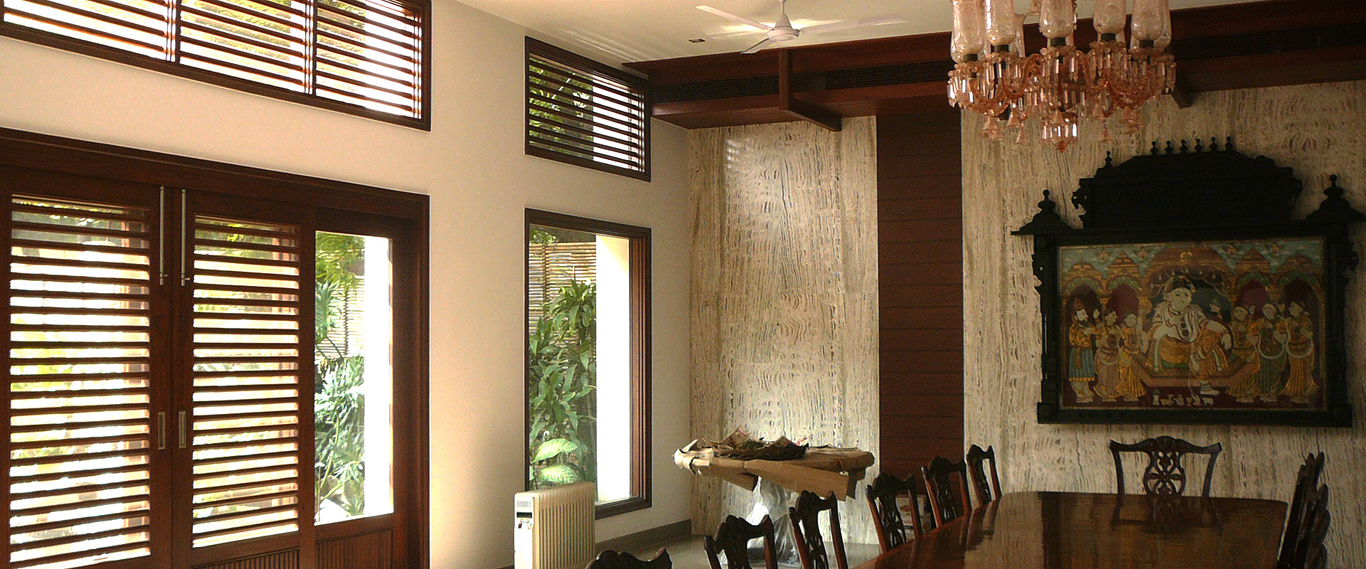

The Client brief was to create an oasis, which erases memory of the busy and chaotic city, leaving only a pleasant atmosphere of peace within the home. The farmhouse is therefore spatially organized such, that the building blocks emerge from green open spaces. All these blocks have openings to these green spaces, and the sensory demand for the foliage to be visual from every living space of the house is met. This is treated more like a space of total Transformation upon entering, especially after the concrete jungle outside.
The site plan has a wall dividing into two areas the overall land parcel, with the closed (living) space on the west, and the open lawn party area on the east. This wall is continuous, to emphasize its form. The wall has four visual punctures in it to create breaks; a continuous lily pool runs along its front to preserve the sanctity of the wall. The upper floor is constructed at an offset to the wall too.

The client wanted the house to be designed keeping the vastu principles in mind. Thus, it was a challenging experience to find the perfect equilibrium between vastu, aesthetics. The orientation is perfectly east facing, which helped in it being aligned with vastu specifications. Similarly, the master bedroom is placed in the south-west corner. This deprived it of all the pleasant views of the front lawn. Hence, the provision of green spaces in the mass of the house provided green visuals to such rooms. In the roofing system the left edge of the valley roof is the highest point, as the south side of a house should be the highest according to vastu principles.
The koi pool in the central open area of the house wraps around it on three sides.

The entire space is divided into four wings. The two wings on the ground floor consist of the common living spaces and the other has the master suite. The two on the upper floor are suits for both the sons with their respective bedrooms, storage, dressers, baths etc. The two wings on any floor are connected by a centre circulatory spine. The steel staircase clad in wood is the vertical circulation, linking the spine on both the floors. It is adjacent to the central open green area. The roof system is a composition of flat roofs, lean-to roofs and valley roofs. For the second phase of
construction the entire material of the roof was changed to steel. Because firstly, it speeds up construction (which was a good thing since the house was inhabited during phase two of construction); secondly it cuts down labor and thirdly, unlike RCC construction methods where water would've seeped to the false ceiling of the lower floor, it was hassle free.

The construction took place in two phases. The first phase consisted of only the ground floor while the second phase, which took place after a gap of 2 years, consisted of the first floor and some other vastu driven changes on the ground floor.

The house has a wooden deck that straddles the swimming pool. It is used for live performances during musical soirees hosted here. The connectivity of the pool, gym, and the bar creates easy access defined by proximity. There is a sculpture room for one of the sons in close proximity of his suite. A mix of earthy tones and white set a warm mood in the house.









Location: New Delhi - NCR, India.
Design team: Nirmal Kulkarni, Deepika Das, Dinesh Banyal, Ashish Kothari.
Gross floor Area: 1300 sqm.
Usage: Farmhouse
Floor: Ground, First
Structure: Reinforced Concrete.
Exterior Finishing: Local sandstone, Himachal slate stone, Exterior paint.
Status: Completed 2011
Client: Withheld
Structural Engineers: Star Consultants, New Delhi.
Public Health Engineers: Gagan Gupta, New Delhi.
HVAC Engineers: Gagan Gupta, Mumbai
Landscape Design: Bios, New Delhi.
Photography: Shailan Parkar, Sushil Khandelwal

